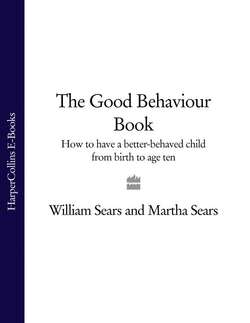Читать книгу The Good Behaviour Book: How to have a better-behaved child from birth to age ten - Martha Sears - Страница 25
1. Respond to Your Baby’s Cries
ОглавлениеBefore you actually hold your baby in your arms you will wonder, “How will 1 ever know what my baby needs?” You will learn quickly because your baby will tell you. The key is to listen and observe. Babies are born with attachment-promoting behaviours (APBs). These behaviours are baby’s earliest language, cues that he uses to communicate his needs. You will find them irresistible; they’re designed to be that way, to penetrate parents to the core, demanding a response. The strongest APB is baby’s cry. Responding to your baby’s cries is the cornerstone of discipline. When your baby cries, pick him up and comfort him. Don’t waste your time wondering, “Should I pick him up?” “Is he trying to manipulate me?” “Will I spoil her?” Just do it.
Don’t worry whether you’ve given the correct response. If your baby is hungry and you try to comfort her by holding and singing rather than feeding her, she will let you know she wants to be fed instead by gnawing on her fists or searching for your breast. With practice, you and your baby will work out the correct cues and responses. Your baby will learn to give you specific cues to specific needs, and you will learn to read body language that signals a specific need. Your response will become less calculated, more intuitive and natural. For some mothers this comes easily; others may need to overcome uncertainty or pre-conceived fears that their baby will control and manipulate them. At some time near the beginning of your parenting career you are likely to hear the advice “Let your baby cry it out” (meaning leave your baby to cry alone). Don’t do it! A baby’s cryis his language – listen to it. A baby’s cry is designed to ensure that his needs for food, holding, rest, and social interaction are met. His cry also develops his mother’s parenting skills. Responding to your baby’s cries is your first exercise in teaching your baby to trust you. It’s an exercise in disciplining your baby.
Effect of mother’s response on baby’s cries.
We do not mean to imply that it is your responsibility to make your baby stop crying. Only baby can do that. It is your job to help him stop crying. Yet there will be times when baby does keep crying because even your holding or feeding doesn’t help, and you’ll have some research to do.* The difference is he’s not being left to cry alone. You continue to hold, rock, bounce, jiggle, take a walk outside – do whatever it takes to help him. Just being with him helps, and you’ll learn as you go. Keeping baby in arms as much as possible helps him cry less and feel supported when he does cry. The cry is baby’s first communication tool. Listen to it.
After the first four to six months, your response to your baby’s fussing will seem to become intuitively less immediate. Baby gradually learns he can wait a bit and anticipate your holding. He can do this because he has learned to trust you and is familiar with that right feeling he gets when you respond to him. You’re in the midst of an activity you want to complete when baby wakes up or decides he’s tired. Instead of rushing over to tend to your baby’s cry you say, “Mummy’s right here …” which can be enough to satisfy baby for a minute or two. Baby develops the ability to wait because he knows you always come. You develop an ear for knowing how urgently he needs you to come.
Teach your baby to cry better. Responding to a baby’s cries is not only good for the baby and the parents, it’s also good for the relationship. Some babies have ear piercing cries that distance them from their parents. These cries shatter nerves and provoke anger, diminishing parents’ enjoyment in being with their baby. Yet immediate responses can help mellow this kind of cry. The opening sounds of baby’s cry are not so aggravating. Instead they have a quality that strikes an empathetic chord in the mother and elicits a nurturing and comforting response. This is the attachment-promoting phase of a baby’s cry. We have noticed that babies whose early cries receive a nurturant response learn to cry better – their cries mellow and do not take on a more disturbing quality. Mothers call these “nicer cries”. But a baby whose cries do not receive an early nurturant response begin to cry in a more disturbing way as she grows angrier. These cries can make the mother angry, promoting an avoidance response. As these babies learn to cry harder, a distance develops between mother and baby. Mothers who follow the advice to let their baby cry it out soon begin giving their babies negative labels, such as “difficult baby” or “fussy baby”. These babies, because their cries go unanswered, use the attachment-promoting phase of the cry less, and the more irritating avoidance-promoting sound more and more. This relationship is at high risk for discipline problems because mother and baby are not communicating well.
The ultimate in crying sensitivity happens when you become so fine-tuned to your baby’s body language that you read and respond to pre-cry signals and intervene before crying is necessary. Baby soon learns he doesn’t have to cry hard (or sometimes at all) to get what he needs. A very attached and nurturant mother who was well on her way to becoming a good disciplinarian told us, “My baby seldom cries. She doesn’t need to.”
